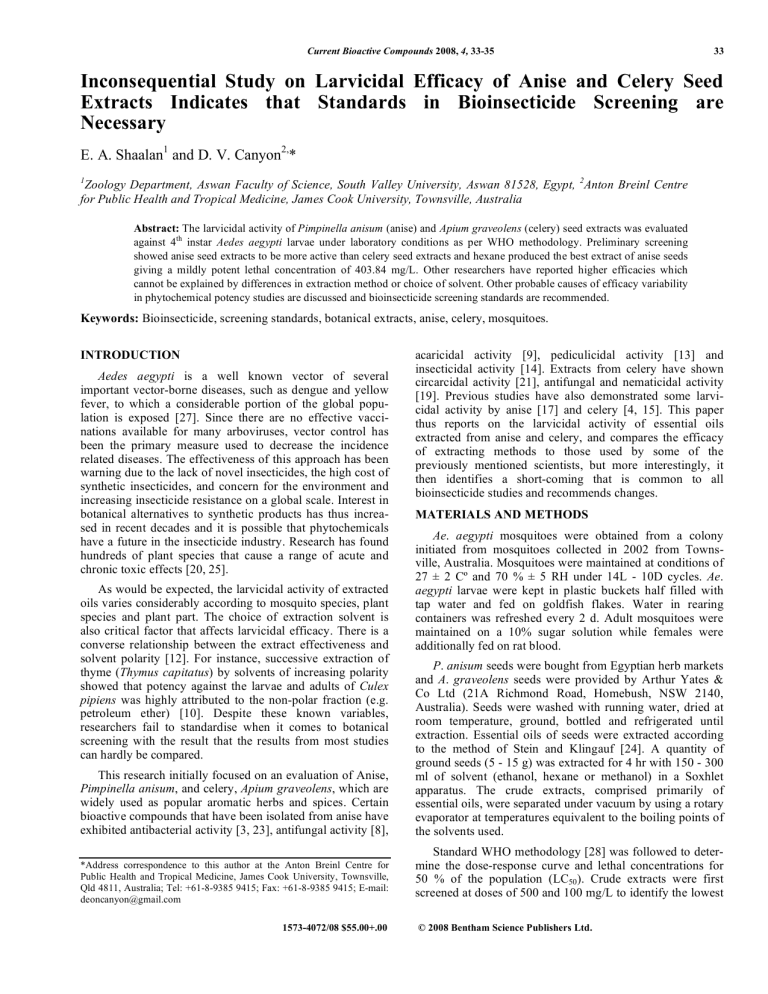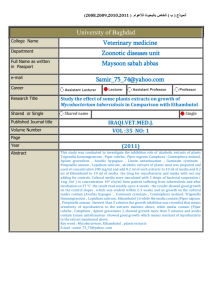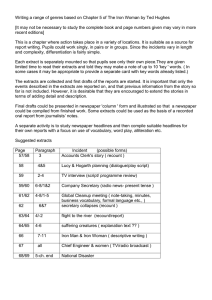) Inconsequential study on larvicidal efficacy of anise and celery seed extracts indicates that standards in bioinsecticide screening are necessary
advertisement

Current Bioactive Compounds 2008, 4, 33-35 33 Inconsequential Study on Larvicidal Efficacy of Anise and Celery Seed Extracts Indicates that Standards in Bioinsecticide Screening are Necessary E. A. Shaalan1 and D. V. Canyon2,* 1 Zoology Department, Aswan Faculty of Science, South Valley University, Aswan 81528, Egypt, 2Anton Breinl Centre for Public Health and Tropical Medicine, James Cook University, Townsville, Australia Abstract: The larvicidal activity of Pimpinella anisum (anise) and Apium graveolens (celery) seed extracts was evaluated against 4th instar Aedes aegypti larvae under laboratory conditions as per WHO methodology. Preliminary screening showed anise seed extracts to be more active than celery seed extracts and hexane produced the best extract of anise seeds giving a mildly potent lethal concentration of 403.84 mg/L. Other researchers have reported higher efficacies which cannot be explained by differences in extraction method or choice of solvent. Other probable causes of efficacy variability in phytochemical potency studies are discussed and bioinsecticide screening standards are recommended. Keywords: Bioinsecticide, screening standards, botanical extracts, anise, celery, mosquitoes. INTRODUCTION Aedes aegypti is a well known vector of several important vector-borne diseases, such as dengue and yellow fever, to which a considerable portion of the global population is exposed [27]. Since there are no effective vaccinations available for many arboviruses, vector control has been the primary measure used to decrease the incidence related diseases. The effectiveness of this approach has been warning due to the lack of novel insecticides, the high cost of synthetic insecticides, and concern for the environment and increasing insecticide resistance on a global scale. Interest in botanical alternatives to synthetic products has thus increased in recent decades and it is possible that phytochemicals have a future in the insecticide industry. Research has found hundreds of plant species that cause a range of acute and chronic toxic effects [20, 25]. As would be expected, the larvicidal activity of extracted oils varies considerably according to mosquito species, plant species and plant part. The choice of extraction solvent is also critical factor that affects larvicidal efficacy. There is a converse relationship between the extract effectiveness and solvent polarity [12]. For instance, successive extraction of thyme (Thymus capitatus) by solvents of increasing polarity showed that potency against the larvae and adults of Culex pipiens was highly attributed to the non-polar fraction (e.g. petroleum ether) [10]. Despite these known variables, researchers fail to standardise when it comes to botanical screening with the result that the results from most studies can hardly be compared. This research initially focused on an evaluation of Anise, Pimpinella anisum, and celery, Apium graveolens, which are widely used as popular aromatic herbs and spices. Certain bioactive compounds that have been isolated from anise have exhibited antibacterial activity [3, 23], antifungal activity [8], *Address correspondence to this author at the Anton Breinl Centre for Public Health and Tropical Medicine, James Cook University, Townsville, Qld 4811, Australia; Tel: +61-8-9385 9415; Fax: +61-8-9385 9415; E-mail: deoncanyon@gmail.com 1573-4072/08 $55.00+.00 acaricidal activity [9], pediculicidal activity [13] and insecticidal activity [14]. Extracts from celery have shown circarcidal activity [21], antifungal and nematicidal activity [19]. Previous studies have also demonstrated some larvicidal activity by anise [17] and celery [4, 15]. This paper thus reports on the larvicidal activity of essential oils extracted from anise and celery, and compares the efficacy of extracting methods to those used by some of the previously mentioned scientists, but more interestingly, it then identifies a short-coming that is common to all bioinsecticide studies and recommends changes. MATERIALS AND METHODS Ae. aegypti mosquitoes were obtained from a colony initiated from mosquitoes collected in 2002 from Townsville, Australia. Mosquitoes were maintained at conditions of 27 ± 2 Cº and 70 % ± 5 RH under 14L - 10D cycles. Ae. aegypti larvae were kept in plastic buckets half filled with tap water and fed on goldfish flakes. Water in rearing containers was refreshed every 2 d. Adult mosquitoes were maintained on a 10% sugar solution while females were additionally fed on rat blood. P. anisum seeds were bought from Egyptian herb markets and A. graveolens seeds were provided by Arthur Yates & Co Ltd (21A Richmond Road, Homebush, NSW 2140, Australia). Seeds were washed with running water, dried at room temperature, ground, bottled and refrigerated until extraction. Essential oils of seeds were extracted according to the method of Stein and Klingauf [24]. A quantity of ground seeds (5 - 15 g) was extracted for 4 hr with 150 - 300 ml of solvent (ethanol, hexane or methanol) in a Soxhlet apparatus. The crude extracts, comprised primarily of essential oils, were separated under vacuum by using a rotary evaporator at temperatures equivalent to the boiling points of the solvents used. Standard WHO methodology [28] was followed to determine the dose-response curve and lethal concentrations for 50 % of the population (LC50). Crude extracts were first screened at doses of 500 and 100 mg/L to identify the lowest © 2008 Bentham Science Publishers Ltd. 34 Current Bioactive Compounds 2008, Vol. 4, No. 1 Shaalan and Canyon dose that kills 100 % of mosquito larvae. About 25 newly moulted 4th instar larvae were released into glass beakers containing 99 ml de-ionized water. Botanical extract (1 ml) was added to each beaker while 1 ml of ethanol was added to the control. Four replicates for each concentration were conducted. Larvae in both test and control were selected from different buckets [26] to avoid effects resulting from rearing differences between batches of larvae. Percentage mortality was recorded after 24 h and Abbott’s formula [1] was used to correct the percentage mortalities if the control mortality was between 5% and 20 %. SPSS version 11 (SPSS Inc.) was used to determine the LC50, LC90 and the corresponding 95 % confidence intervals of the extracts. RESULTS AND DISCUSSION The initial results of the present study, presented in Table 1, show that out of the three extracts tested, only ethanol and hexane extracts of P. anisum produced 100 % mortality when tested against Ae. aegypti larvae at 500 mg/L. In contrast, larval mortality caused by extracts of A. graveolens at the same concentration ranged from 12-59%. This indicated that an extremely high, unpractical concentration would be needed to produce 100 % mortality. Accordingly, A. graveolens was considered non effective against Ae. aegypti larvae and its dose-response curve was not evaluated. At 100 mg/L, the P. anisum, extracts produced a mortality of 1.35 - 11.12 %, indicating a LC50 between 100 and 500 mg/L. Because the hexane extract produced the highest mortality at 100 mg/L, its dose-response curve was determined. It was shown to be marginally effective with an LC50 of 251.14 mg/L (Table 2). Our results showed lower efficacy than those reported by Prajapati et al. [17] for P. anisum (LC95 = 115.7 mg/L), by Choochote et al. [4] for A. graveolens (LC50 = 81 mg/L), and for A. graveolens (LC50 = 40.07 mg/L) by Pitasawat et al. [15]. Although it is tempting to dismiss studies that show such large variations, there are some very good explanations. These differences are, in part, influenced by the extracting method and the solvent [20]. In the present study, a Soxhlet apparatus was used to extract essential oils with 3 solvents whilst hydro distillation [17], steam distillation [15] and ethanol maceration [4] were the methods used for extraction in the other studies. However, this does not explain all since Chahad and Boof [2] reported that Piper nigrum extracts obtained using the Soxhlet method produced higher mortality against Cx. quinquefasciatus larvae and reduced lethal time than the extract obtained by maceration. Thus, our results should have shown lower lethal concentrations than those obtained by other methods, but this was not the case and further explanation was sought. When it comes to comparing the results from different studies, in addition to keeping extraction methods identical, other biological factors must be taken into account. In the same way that viruses vary in virulence, the quantity of active phytochemical in any given plant will vary due to a whole range of spatial, temporal and biological factors. The origin of plant material, nutrition, accumulation of bioactive Table 1. Preliminary Screening of Pimpinella anisum and Apium graveolens Extracts Against Newly Moulted 4 th Instar Larvae of Aedes aegypti Botanical extracts Pimpinella anisum Apium graveolens 500 Mg/L 100 Mg/L 500 Mg/L 100 Mg/L Ethanol extract 100 1.35 41 2 Hexane extract 100 11.12 59 0 Methanol extract 89 3.25 12 3 Control 0 0 0 0 Table 2. LC50, LC90, and Slope Data of Pimpinella anisum Hexane Extract Tested Against Newly Moulted 4th Instar Larvae of Aedes aegypti Conc. Mean LC50 LC90 Slope ± SE (ppm) mortality % Mg/L 95 % FL Mg/L 95 % FL 450 96.0 251.14 233.11-267.95 403.84 381.56-431.42 400 86.0 300 73.0 200 28.3 50 5.5 Control 0 0.0083 ± 0.00062 Inconsequential Study on Larvicidal Efficacy of Anise Current Bioactive Compounds 2008, Vol. 4, No. 1 compounds during growth and development and influence of harvest time may all have a significant impact on the quality and quantity of phytochemicals [18, 6]. For instance, Policegoudra et al. [16] found that growth and developmental stages of mango ginger, Curcuma amada, rhizomes influenced the accumulation of bioactive compounds, particularly difurocumenonol, a bioactive terpenoid compound, and phenolics. Harvest time was found to affect the quantity of oil-based bioactive compounds in sea buckthorn berries, Hippophae rhamnoides L. ssp. Sinensis [5]. November-harvested berries yielded the highest carotenoid content in the fruit fraction (p < 0.05) and September yielded significantly higher (p < 0.05) levels of major compounds, -tocopherol and -sitosterol, in the fruit fraction. Indeed, such variables may go further in explaining differences in research results than normally considered variables. Accordingly, it is not realistic or sensible to compare the results from studies in which the spatial, temporal and/or environmental conditions, particular to the tested botanical material, have not been standardised. Furthermore, the rearing conditions of mosquitoes are well known to influence results and the WHO [26] even recommended that test populations be drawn from several different batches to minimise this effect. Why is it that plant materials are not subject to the same scientific rigour? Articles on promising botanical insecticides should thus include plant rearing data and future studies need to determine the ideal growing conditions required to produce the maximum potency and quantity of active product. Identification of superior strains of species with potential would also be of benefit. ACKNOWLEDGEMENTS REFERENCES [2] [3] [4] [5] [6] [7] [10] [11] [12] [13] [14] [15] [16] [17] [19] [20] [21] Abbott, W.S. (1925) A method of computing the effectiveness of an insecticide. J. Econ. Entomol., 18, 256-257. Chahad, S.; Boof, M.I.C. (1994) Effect of black-pepper extracts on the larvae of Culex (Culex) quinquefasciatus Say (Diptera: Culicidae). An. Soc. Entomol. Brasil, 23, 13-18. Chaudhry, N.M.; Tariq, P. (2006) Bactericidal activity of black pepper, bay leaf, aniseed and coriander against oral isolates. Pak. J. Pharm. Sci., 19, 214-218. Choochote, W.; Tuteun, B.; Kanjanapothi, D.; Rattanachanpichai, E.; Chaithong, U.; Chaiwong, P.; Jitpakdi, A.; Tippawangkosol, P. (2004) Potential of crude seed extract of celery, apium graveolens L.; against mosquito Aedes aegypti (L.) (Diptera: Culicidae). J. Vect. Ecol., 29, 340-346. George, S.D.S.; Cenkowski, S. (2007) Influence of harvest time on the quality of oil-based compounds in sea buckthorn (Hippophae rhamnoides L. ssp. sinensis) seed and fruit. J. Agr. Food Chem., 55, 8054-8061. Hemming, J.D.C.; Lindroth, R.L. (1999) Effects of light and nutrient availability on Aspen: growth, phytochemistry, and insect performance. J. Chem. Ecol., 25, 1687-1714. Karmegam, N.; Sakthivadivel, M.; Anuradha, V.; Daniel, T. (1997) Indigenous plant extracts as larvicidal agents against Culex quinquefasciatus Say. Biores. Technol., 59, 137-140. Received: January 16, 2008 [9] [18] We are indebted to Prof Bruce Bowden, School of Pharmacy and Molecular Sciences, James Cook University, Queensland, Australia for use of his laboratory, and Rev. Dr. Wayne Melrose, Director of the World Health Organization Collaborative Center for the Control of Lymphatic Filariasis, James Cook University, Queensland, Australia for funding. [1] [8] [22] [23] [24] [25] [26] [27] [28] 35 Kosalec, I.; Pepeljnjak, S.; Kustrak, D. (2005) Antifungal activity of fluid extract and essential oil from anise fruits (Pimpinella anisum L.; Apiaceae). Acta Pharm., 55, 377-385. Lee, H.S. (2005) Food protective effect of acaricidal components isolated from anise seeds against the stored food mite, Tyrophagus putrescentiae (Schrank). J. Food Prot., 68, 1208-1210. Mansour, S.A.; Messeha, S.S.; EL-Gengaihi, S.E. (2000) Botanical biocides. 4. Mosquitocidal activity of certain Thymus capitatus constituents. J. Nat. Tox., 9, 49-62. Moawed, H.A.M. (1998) Joint action of some plant extracts against the mosquito larvae of Culex pipiens and their physiological impact. M.Sc. Thesis, Faculty of Science-Dmietta, Mansoura University, Egypt. Mulla, M.S.; Su, T. (1999) Activity and biological effects of neem products against arthropods of medical and veterinary importance. J. Am. Mosq. Contr. Assoc., 15, 133-152. Mumcuoglu, K.Y.; Miller, J.; Zamir, C.; Zentner, G.; HelbIn, V.; Ingber, A. (2002) The in vivo pediculicidal efficacy of a natural remedy. Israel Med. Assoc. J., 4, 790-793. Park, I.; Choi, K.; Kim, D.; Choi, I.; Kim, L.; Bak, W.; Choi, J.; Shin, S. (2006) Fumigant activity of plant essential oils and components from horseradish (Armoracia rusticana), anise (Pimpinella anisum), and garlic (Allium sativum) oils against Lycoriella ingenua (Diptera: Sciaridae). Pest Manage. Sci., 62, 723-728. Pitasawat, B.; Champakaew, D, Choochote, W, Jitpakdi, A.; Chaithong, U.; Kanjanapothi, D.; Rattanachanpichai, E.; Tippawangkosol, P.; Riyong, D.; Tuetun, B.; Chaiyasit, D. (2007) Aromatic plant-derived essential oil: An alternative larvicide for mosquito control. Fitoterapia, 78, 205-210. Policegoudra, R.S.; Kumar, M.H.S.; Aradhya, M.S. (2007) Accumulation of bioactive compounds during growth and development of mango ginger (Curcuma amada Roxb.) rhizomes. J. Agr. Food Chem., 55, 8105-8111. Prajapati, V.; Tripathi, A.K.; Aggarwal, K.K.; Khanuja, S.P.S. (2005) Insecticidal, repellent and oviposition-deterrent activity of selected essential oils against Anopheles stephensi, Aedes aegypti and Culex quinquefasciatus. Biores. Technol., 96, 1749-1757. Price, P.W.; Waring, G.L.; Julkunen-Titto, R.; Tahvanainen, J.; Mooney, H.A.; Craig, T.P. (1989) Carbon-nutrient balance hypothesis in within-species phytochemical variation of Salix lasiolepis. J. Chem. Ecol., 15, 1117-1131. Rafikali, A.M.; Muraleednaran, G.N. (2001) Mosquitocidal, nematicidal and antifungal compounds from Apium graveolens L. seeds. J. Agric. Food Chem., 49, 142-145. Shaalan E.A.; Canyon D.V.; Yones M.W.F.; Abdel-Wahab H.; Mansour A. (2005) A review of botanical phytochemicals with mosquitocidal potential. Environ. Intnl., 31, 1149-1166. Saleh, M.M.; Zwaving, J.H.; Malingre, T.M.; Bos, R. (1985) The essential oil of Apium graveolens var. secalinum and its cercaricidal activity. Pharm. Week Sci., 7, 277-279. Shalaby, A.A.; Allam, K.A.; Mostafa, A.A.; Fahmy, S.M. (1998) Insecticidal properties of citrus oils against Culex pipiens and Musca domestica. J. Egypt Soc. Parasitol., 28, 595-606. Singh, G.; Kapoor, I.P.S.; Pandey, S.K.; Singh, U.K.; Singh, R. K. (2002) Studies on essential oils. Part 10; Antibacterial activity of volatiles oils of some spices. Phyto. Res., 16, 680-682. Stein, U.; Klingauf, F. (1990) Insecticidal effect of plant extracts from tropical and subtropical species. J. Appl. Entomol., 110, 160166. Sukumar, K.; Perich, M.J.; Boobar, L.R. (1991) Botanical derivatives in mosquito control: A review. J. Am. Mosq. Contr. Assoc., 7, 210-237. World Health Organization (1996) Report of the WHO informal consultation on the evaluation and testing of insecticides. CTD/ WHOPES/IC/96.Geneva, Switzerland: World Health Organization. World Health Organization (2003) Dengue. http://www.who.int/ inf-fs/en/fact117.html (Accessed March 2008). World Health Organization (2005) Guidelines for laboratory and field testing of mosquito larvicides. WHO/CDS/WHOPES/ GCDPP/2005.13. Revised: January 18, 2008 Accepted: February 4, 2008
![Literature and Society [DOCX 15.54KB]](http://s2.studylib.net/store/data/015093858_1-779d97e110763e279b613237d6ea7b53-300x300.png)


